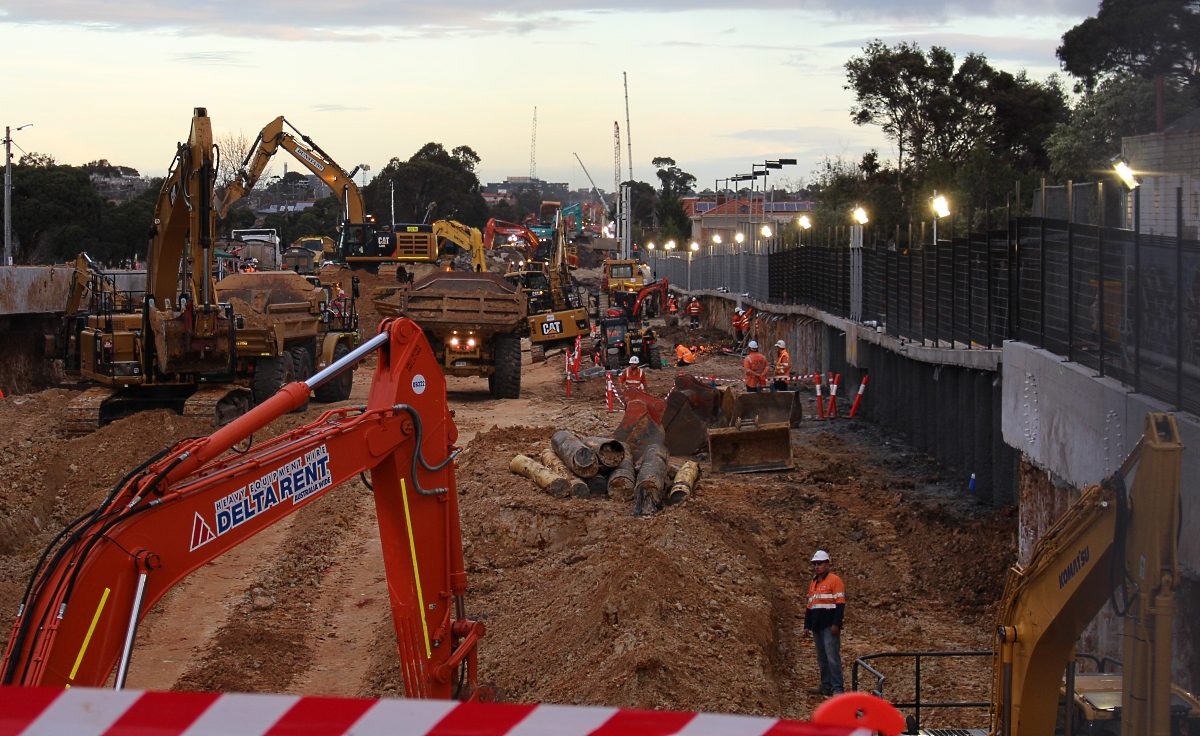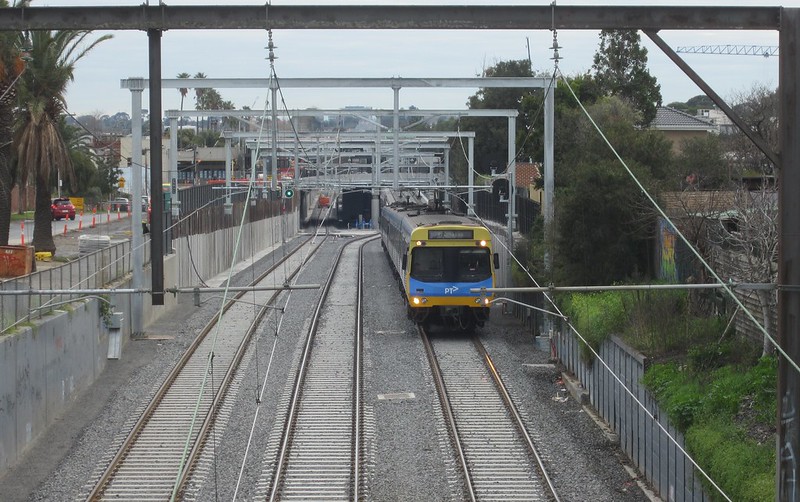What they got done at Bentleigh, Mckinnon and Ormond during the 37 day shutdown of the Frankston line to remove the level crossings was very impressive, and I’m told the project team are (rightly) proud of the results.
37 days of round-the-clock works, 3 of the worst level crossings gone. Watch them disappear in 3 minutes. #springsthttps://t.co/OO5DpMnhdO
— Daniel Andrews (@DanielAndrewsMP) August 11, 2016
But… particularly when evaluating different methodologies and plans for future projects, one needs to be very careful to get all the facts.
It’s simply incorrect to imply that 37 days was the full extent of disruptions.
The full scope of interruptions to trains has been far greater.
Here’s a list of the extended station closures and service alterations:
- Third track closed, resulting in no peak hour express trains from Mon 16/11/2015 until Sun 4/9/2016 — 10 months. This was clever thinking, because it’s provided construction access in a narrow corridor. This might not be available on other projects.
- For the same ten months, several planned regular peak hour cancellations, obviously adding to crowding on other trains.
- Closure of Ormond station 25/3/2016 to late August 2016 — 5 months
- Closure of Mckinnon station 25/3/2016 to 31/7/2016 — 4 months
- Closure of Bentleigh station from 4/6/2016 to late August 2016 — 3 months
And the rail closures (not including an accidental disruption due to a gas leak early in the project):
- Last two trains after midnight, Fri 13/11/2015 — this was before Night Trains started
- 1am Sat 21/11/2015 to last service Sun 22/11/2015 — 2 days
- 1am Sat 28/11/2015 to last service Sun 29/11/2015 — 2 days
- 1am Sat 12/12/2015 to last service Sun 13/12/2015 — 2 days
- First service Sat 23/1/2016 to last service Sun 31/1/2016 — 9 days
- 8:45pm Fri 12/2/2016 to last service Sun 14/2/2016 — 2 days
- 7pm Fri 4/3/2016 to last service Sun 6/3/2016 — 2 days
- 9pm Fri 19/3/2016 to last service Sun 21/3/2016 — 2 days
- First service Fri 25/3/2016 (Good Friday) to last service Sun 3/4/2016 — 3 days
- First service Sat 25/6/2016 to last service Sun 31/7/2016 — 37 days — including normal weekdays
- 1am Sat 13/8/2016 to last service Mon 15/8/2016 — 3 days — note this includes all of Monday, a normal weekday
Edit: additional closures:
- 1am Sat 27/8/2016 to last service Sun 28/8/2016 — 2 days — a planned closure on the Monday has thankfully been avoided
- 8:45pm Sat 3/9/2016 to 6am Sun 4/9/2016 — just overnight
- 8pm Fri 4/11/2016 to last service Sun 6/11/2016 — 2 days
(In most cases, rail closures were confined to Caulfield to Moorabbin. In some cases this was stretched to Mordialloc, mostly for other projects such as Southland station, though early on this was done as part of work to isolate the power at Moorabbin.)
So in fact there have been substantial disruptions in addition from the 37 days: 10 months of service alterations/cancellations, stations closed for up to 5 months, and so far (that we know about) 29 31 full days of closures — eg a full total of 68 days with no trains.
Weekend closures are less disruptive than weekdays, but still affect a large number of people, especially on weekends with major sporting and cultural events.
The full project spans over a year of works.
Preparatory work was required, such as moving existing services, ahead of major works. Further (mostly relatively minor) work is required to bring the project to completion.
It’s like when you go in for a short surgical procedure. There’s all kinds of preparation before the actual event, and recovery time afterwards. It’s not just a half-hour thing, it can take all day.
I’m not saying the project should have been run differently. Actually it’s been a really good strategy to isolate the main disruption to a five-ish week period, and overall things have gone pretty smoothly.
But we need to be clear on what actually happened, and not assume it was just 37 days.
- By the way, Marcus Wong has fact-checked the rhetoric: It’s unlikely the 37 days was the “biggest rail closure since the City Loop” (though it probably ranks in terms of numbers of passengers disrupted). And it’s not the first time three crossings have been removed simultaneously (though the recordholders are over 95 years ago).
- In my view there hasn’t been nearly enough publicity about this coming Monday’s closure (as well as the weekend). The blaze of publicity about the line re-opening probably has people assuming there are no more weekday shutdowns. Not so! PTV notice here.
Update 23/8/2016: the new Bentleigh and Ormond stations will open on August 29th.
BREAKING: Bentleigh & Ormond stations opening Monday 29 Aug – two days ahead of schedule! #gettingitdone pic.twitter.com/9hYYXEkkKl
— Nick Staikos MP (@NStaikos) August 23, 2016



10 replies on “It wasn’t just a 37 day project”
“It’s like when you go in for a short surgical procedure. There’s all kinds of preparation before the actual event”.
Yes, I know the one you mean. The preparation is the worst part.
You should probably also include the carparks closures. Bentleigh, McKinnon and Ormond have have reduced, or zero, car parking for most of the project.
@Michael, that’s true – I was concentrating on direct rail service impacts, but if you look at the total impact there’s been (and continues to be) quite a bit. There have been car park closures, road closures (impacting bus services), partial road closures, contra-flow systems, non-station off-street parking closures, on-street parking restrictions, power outages, noise and dust/dirt, park playing fields unavailable, additional road traffic and train passenger on alternative routes… and probably other effects I haven’t listed here.
By the way, some of the landscaping (to replace the many trees and plants removed) won’t be done until autumn 2017 (when new plantings are more likely to take), so by the time the project is completely finished it will have been close to two years since they started in mid-2015.
Possibly the longest rail closure in a non-school holiday period? In terms of total rail disruption in days, the Regional Rail impact on the Sunbury and Werribee lines might have been similar. I recall 3 or 4 closures between Sunshine and Footscray in school holidays, and there would have been weekends as well on both the Sunbury and Werribee lines.
Prior to this project, how many projects have we had, where we removed three level crossings in one go?
I can not think of any.
The vast majority of projects had been only one crossing at one time, except for the following, where each had two crossings at one time;
++ Sunshine
++ Mitcham
I trust there will be many ‘multiple crossing’ projects to happen soon, with three lots on the Dandenong corridor, and many others.
Last Thursday, I had a ride through to Patterson and back to have my train seat view of the project.
It sure was a roller coaster ride.
Questions I will ask are;
++ Are there going to be tunnel lights where we go under at Ormond?
++ Is there any provision for 9 car trains on this line?
++ Any provision for a fourth track to go in one day?
All good but it happened and it’s almost done!
I see bleats from those affected by the works around Ormond/ McKinnon / Bentleigh (some of the shopkeepers seem very bitter – even now – yet the road closures are largely over…and importantly the routine closures from level crossings are definitely behind us)
Wandering around Hughesdale and Murrumbeena last weekend I saw a lot of signs demanding “no sky rail”
Now Melbourne hospitals are bleating about prospective issues with Metro tunnelling
Let’s just get on with it!
Recently Perth apparently had its longest continuous rail shutdown in history but it was 1.5 weeks
http://www.watoday.com.au/wa-news/transperth-plans-major-train-shutdown-to-connect-new-stadium-station-20160620-gpn7av.html
I’m curious to know why Victoria have much longer shutdowns for rail projects
@Dan, the specifics of each project will drive the shutdown time.
In the Perth example, the article makes it clear that they have built the new station on a brand new route, parallel to the existing rail line.
The 37 day shutdown this blog post is about concerns a rail alignment that was too narrow for that. So during the shutdown they demolished the three stations and the entire rail line, dug it all out and rebuilt the tracks and the stations at a lower level. Has Perth done a similar project?
Melbourne has had level crossing removals similar to the Perth Stadium project; at Springvale and Gardiner the new station was built alongside the old, and I think St Albans is underway now using the same method. This obviously results in far less disruption.
[…] thanks to the 37 day rail shutdown in July, we […]
[…] my calculation the Frankston line shutdowns (for three crossings at Bentleigh, Mckinnon and Ormond) totalled 66 days: 36 on weekends/public holidays, 14 weekdays in school holidays, and 30 normal […]